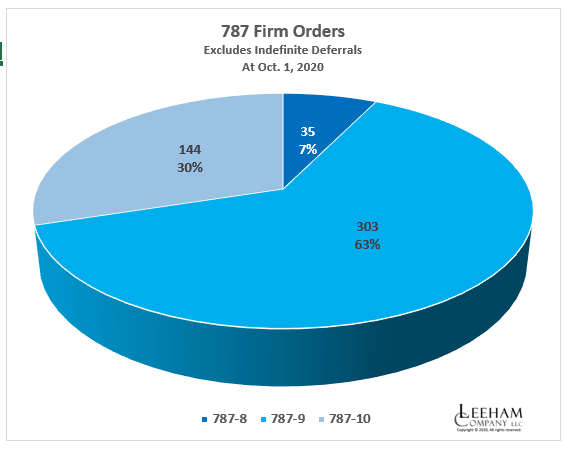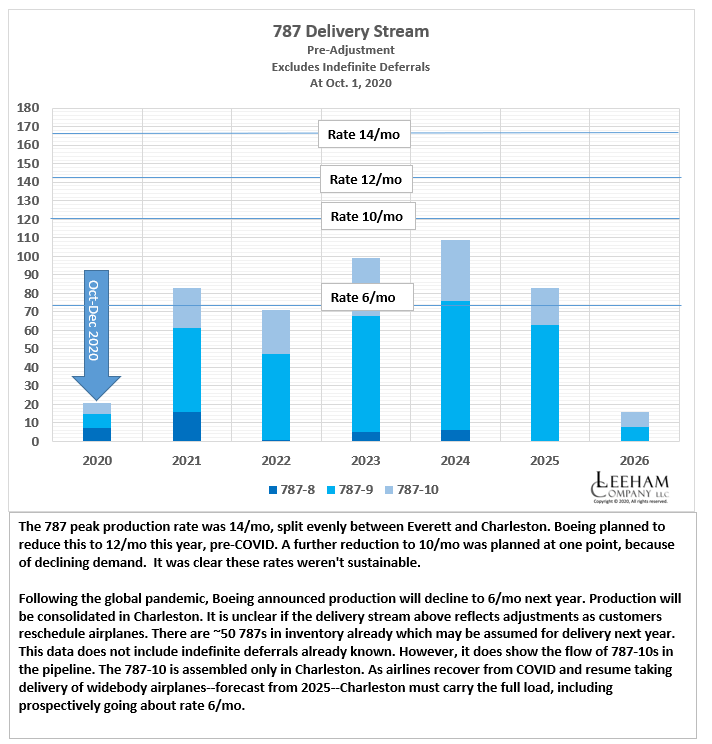Leeham News and Analysis
There's more to real news than a news release.
Boeing 787 SC plant has room to increase production in current building: Exclusive Leeham News Analysis
Now open to all readers.
By the Leeham News Team
Introduction
Nov. 2, 2020, © Leeham News: When Boeing announced consolidation of the 787 Program in Charleston, Washington State and local officials—as well as thousands of employees—hoped that if production rates recovered, the final assembly line in Everett would reopen.
However, for Everett and Washington State, the message is clear. The 787 is leaving for good.
Boeing made it clear that consolidation wouldn’t happen if Charleston couldn’t grow the production beyond the current maximum of 7/mo.
LNA’s analysis makes it clear the South Carolina facility can do so.
The Charleston FAL is positioned to build all future 787s, at rates higher than the recent 7/mo maximum.
Summary
- The Charleston FAL can go higher than the historical maximum of 7/mo without capital expenditures.
- Production rates can increase under the current process more than 40%.
- Rates can increase more than 70% with some process changes.
- The current FAL can accommodate these higher rates.
Discussion
Background and Definitions
In order to understand the case for all future 787 production to occur in Charleston, we need to get into some of the nuts and bolts of manufacturing to understand how the system works.
First thing right out of the box is the understanding that Boeing doesn’t run an assembly line in the classic sense of the word. Assembly lines produce items with a few variations to fill demand that is expected to be there to consume the product.
Boeing doesn’t do this. Boeing actually pre-sells each aircraft to a specific customer the way that customer wants it. The airplane configuration possibilities are virtually limitless. Boeing produces aircraft one at a time, really quickly, in a very tightly controlled environment.
The system making this happen is called MRP, Manufacturing Resources Planning. It is an industry standard process that schedules the production of all the separate parts and assemblies that make up the airplane. This is where the magic happens, and it starts with a thing called a Production Day. A Production Day is defined as a day that normal work would be scheduled. In most cases, weekends and holidays are not counted. Boeing currently uses an MRP system based on a five day work week
You start with the delivery date and work backwards in the individual airplanes schedule to get all the parts as well as schedule each specific assembly job so that the cascade of that airplanes work moving through the factory is orderly and controlled.
It’s all about people, parts and paperwork. Employee headcount is regulated by how many jobs need to be “Sold Off.” Each job has a labor time assigned to it so people get scheduled to complete the tasks on time. These times slowly improve every airplane in a process called a learning curve. Do a task often enough and you can perform it more efficiently each time you do it.
Crunching numbers for throughput
Let’s crunch the numbers to show Charleston’s projected maximum throughput without facility additions to the 80-33 FAL building.
Charleston demonstrated the ability to assemble seven 787s a month. It has not always gone perfectly at that rate as there have been instances of shuffling aircraft from the ramp and back into the 80-33 building to complete late work. But absent extenuating circumstances, it looks to be a doable rate on a sustainable basis.
Boeing schedules Charleston to operate 249 days a year. The Boeing MRP system counts weekdays as Production Days, it does not count weekends or holidays. This means there are 20.75 Production Days/month and this corresponds to 62.25 available shifts average/month.
Boeing Historically operates a schedule with a Day shift, a smaller Second shift, and a skeleton Third shift. Charleston manpower distributed across three shifts probably has a second shift manned at less than 65% of Day shift, and third shift at less than 35% of Day shift. These are common labor distributions found in many manufacturing operations.
Using this conservative labor distribution, we can see that Charleston uses two equivalent shifts at 20.75 Production Days a month to build seven aircraft. This means that 41.5 full shift equivalents produced seven aircraft. Therefore, approximately six shifts (5.98) produced one aircraft. This is a proven rate they have sustained in the past. But it isn’t good enough to close the door on an Everett Line Restart.
Fully staffed shifts
Using full staffing of the second and third shifts would add another 3.45 aircraft to the Charleston rate by using the 20.75 equivalent shifts not being utilized today.
This gets Charleston to a 10.5 aircraft/month line rate, using the current five Production Day-based MRP system and working with the assumption that there is no headroom for day shift workers to be added. This adds yet another small conservative margin to our calculations. Ten-and-a-half aircraft per month is a great effort, but we see more possibilities.
Spinning off the 787
We see a solid case for splitting the 787 off from BCA as a stand alone division again. If the 787 was on its own, it could move to a six Production Day/week MRP system. This provides 301 Production Days a year or 25.08 Production Days a month. Seventy-five shifts become available per month and this gets you 12.5 aircraft/month without adding to the 80-33 building using the same metrics that you used to get to 10.5 on a five Production day week.
If the 787 was its own division, all of this would be much easier to do without having to drag the legacy programs off of their five day schedules. Other reasons for a seperate 787 division revolve around isolating the South Carolina non-union workforce and management from the Unionised BCA operations. This would simplify the implementation of automotive industry platoon staffing and shift rotation necessary to make sustained production beyond 10 a month possible. It would also prevent crosstalk of the two parallel MRP systems, BCA’s Five Production Day and Charleston’s Six Production Day system necessary to go above a 10 ½ ship/month line rate
Lower costs
The labor cost index shows the Pacific Northwest (ie, including Washington State) is 114% of the norm in the US. The Southeast, including South Carolina, is 88% of the norm. Allowing for variances, call it a 25% difference.
In 2017, a Boeing Charleston official told LNA Boeing headquarters in Chicago calculated that the Charleston FAL was 20% more efficient than the Everett line.
Final assembly represents only about 8% of the total cost of an airline. This means the cost savings of final assembly is 20% of 8%, or about 1.6% of the total cost of producing the airplane. If, for example, it costs $90m to produce a 787, 1.6% equals $1.44m.
Multiply this times the number of airplanes produced a month time the annual rate times the remaining life of the program, the savings add up. Additionally, it extends the service life of the Dreamlifter fleet by eliminating the sortees going to Everett.
Stick a fork in Everett
In the end, none of the changes required to go to 12.5 aircraft a month are show stoppers. Boeing has time to get there as production will take time to get back to those rates, if they ever do.
And with that, the fork was put in Everett.



excellent! thanks for this background info, which makes the Charleston decision understandable to non-insiders.